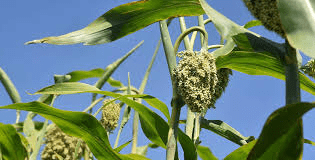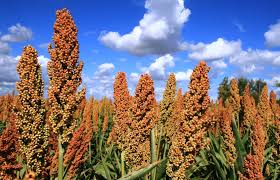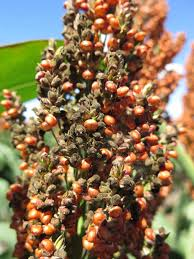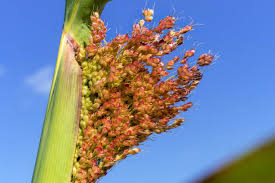The guinea corn panicle is a crucial part of the sorghum plant (Sorghum bicolor), playing a central role in its reproductive cycle and contributing significantly to its agricultural and economic value. The panicle is the flowering head of the sorghum plant, where the seeds develop and mature. It is typically a large, branched cluster that holds the grain, which is harvested for various uses.
Structurally, the guinea corn panicle is composed of numerous spikelets, each containing one or more florets. These florets develop into the grains or seeds of the plant. The panicle can vary in size, shape, and color, depending on the sorghum variety. Some panicles are compact and dense, while others are more open and spread out. This diversity in panicle structure is often used in breeding programs to develop sorghum varieties suited to different growing conditions and uses.
One of the primary roles of the guinea corn panicle is to house the seeds, which are the main product harvested from the sorghum plant. These seeds are a vital food source in many parts of the world, particularly in Africa and Asia. Sorghum grains are rich in carbohydrates, providing a significant energy source.
They also contain protein, dietary fiber, and essential vitamins and minerals, making them a nutritious food staple. The grains can be milled into flour for baking, used whole in cooking, or processed into various food products such as porridge, bread, and beverages.
In addition to its importance in food production, the guinea corn panicle is also valuable in agriculture as a seed source for planting. High-quality seeds from mature panicles are collected and used to grow new crops, ensuring the continuity and productivity of sorghum farming. Seed selection and breeding efforts focus on improving traits such as yield, drought tolerance, pest resistance, and nutritional content, which are critical for enhancing the overall performance and sustainability of sorghum cultivation.
The guinea corn panicle has industrial uses as well. Sorghum grains are used in the production of alcoholic beverages such as beer and spirits in various cultures. The fermentation process converts the starches in the grains into alcohol, creating traditional drinks that are an integral part of many social and cultural practices.
Additionally, sorghum grains are used in the production of biofuels, particularly ethanol. The grains’ high starch content makes them an efficient feedstock for ethanol production, contributing to renewable energy solutions and reducing dependence on fossil fuels.
Beyond its direct uses, the guinea corn panicle also has implications for environmental sustainability. The robust nature of the sorghum plant, including its panicles, allows it to thrive in harsh conditions such as drought and poor soils.
This resilience makes sorghum a critical crop for food security in regions prone to climate variability and limited water resources. The plant’s deep root system and efficient water usage help conserve soil moisture, making it a valuable component of sustainable agricultural systems.
In research and development, the guinea corn panicle is a focus of genetic studies aimed at improving sorghum’s adaptability and productivity. Scientists are exploring ways to enhance the panicle’s size, grain quality, and resistance to pests and diseases through traditional breeding techniques and modern biotechnology. These efforts are essential for developing sorghum varieties that can meet the challenges of changing climates and growing populations.
In conclusion, the guinea corn panicle is a vital part of the sorghum plant, central to its reproductive process and agricultural value. Its role in grain production, seed propagation, industrial applications, and environmental sustainability underscores its importance in global agriculture.
The diverse uses and ongoing research into improving the panicle highlight its potential to contribute to food security, economic development, and sustainable farming practices.
The Economic Importance and Uses of Guinea Corn Panicle

1. Grain Production: The panicle holds the seeds of guinea corn, which are a staple food crop in many regions.
2. Animal Feed: Panicles, including the grains and chaff, are used as feed for livestock, providing essential nutrients.
3. Seed Harvesting: The panicles are harvested for seeds, which can be used for planting future crops.
4. Biofuel Production: The grains from the panicles can be processed into bioethanol, contributing to renewable energy sources.
5. Traditional Medicine: Some cultures use parts of the panicle in traditional medicinal practices.
6. Crafts and Decorations: The panicles are used in making decorative items and crafts due to their unique structure.
7. Bird Feed: Panicles are used as bird feed, providing a natural and nutritious diet for domesticated birds.
8. Composting: The remnants of panicles after harvesting can be composted to create organic fertilizer.
9. Food Security: The grains from the panicles are a crucial source of food, ensuring food security in many regions.
10. Beverage Production: The grains are used in brewing traditional alcoholic and non-alcoholic beverages.
11. Economic Growth: Cultivating and selling guinea corn panicles contribute to the local economy, particularly in rural areas.
12. Export Commodity: The grains from the panicles are traded internationally, providing foreign exchange earnings for producing countries.
13. Dietary Fiber: The grains provide dietary fiber, which aids in digestion and promotes gut health.
14. Gluten-Free Products: The grains are used to produce gluten-free flour for people with gluten intolerance or celiac disease.
15. Research and Development: Guinea corn panicles are studied for improving crop yields and developing new agricultural techniques.
16. Industrial Uses: The grains and chaff are used in producing various industrial products, such as adhesives and dyes.
17. Soil Fertility: Residue from the panicles can be used to improve soil fertility through mulching and composting.
18. Cultural Significance: The panicles are integral to various cultural practices and cuisines, preserving heritage and traditions.
Read Also: How often you need to Change Water in your Fish Farm
The Products and By-products That Can Be Derived From Guinea Corn Panicle

1. Grains: The primary product from panicles is the grain, used as a staple food and for other purposes.
2. Animal Feed: Panicles, including grains and chaff, are processed into feed for livestock.
3. Bioethanol: Grains from the panicles are fermented to produce bioethanol, a renewable fuel.
4. Bird Feed: Whole panicles are used as feed for birds.
5. Compost: Residual panicle material is composted to produce organic fertilizer.
6. Mulch: Panicle remnants are used as mulch to retain soil moisture and suppress weeds.
7. Craft Items: Panicles are used in making crafts and decorative items.
8. Alcoholic Beverages: Grains from the panicles are used in brewing traditional beers and spirits.
9. Non-Alcoholic Beverages: The grains are used to make non-alcoholic drinks.
10. Flour: The grains are milled into gluten-free flour for baking.
11. Glucose Syrup: The grains are processed to produce glucose syrup, used in confectionery.
12. Adhesives: By-products from panicles are used in making industrial adhesives.
13. Dyes: Panicle residues are used in producing natural dyes.
14. Bio-plastics: Grains and chaff are used in the production of biodegradable plastics.
15. Organic Fertilizer: Decomposed panicle material is used as organic fertilizer.
16. Traditional Medicines: Parts of the panicle are used in traditional medicinal preparations.
17. Research Materials: Panicles are used in agricultural research to develop improved crop varieties.
Read Also: 14 Medicinal Health Benefits of Ghost Pepper (Capsicum Chinese)
Frequently Asked Questions (FAQ’s) About Guinea Corn Panicle

1. What is a guinea corn panicle?
A guinea corn panicle is the flowering part of the guinea corn plant that holds the seeds.
2. How are guinea corn panicles used in agriculture?
They are harvested for grains, used as animal feed, and composted to enrich soil.
3. Can guinea corn panicles be used for biofuel?
Yes, the grains from the panicles can be processed into bioethanol.
4. What products can be made from guinea corn panicles?
Products include grains, animal feed, bioethanol, bird feed, and crafts.
5. Are guinea corn panicles used in traditional medicine?
Yes, some cultures use parts of the panicle in traditional medicinal practices.
6. How do guinea corn panicles contribute to food security?
The grains from the panicles are a crucial source of food in many regions.
7. Can guinea corn panicles be used for bird feed?
Yes, whole panicles are used as bird feed.
8. What is the economic importance of guinea corn panicles?
They contribute to local economies, provide employment, and are an export commodity.
9. How are guinea corn panicles used in composting?
Residual panicle material is composted to create organic fertilizer.
10. Are guinea corn panicles used in beverage production?
Yes, the grains are used in brewing both alcoholic and non-alcoholic beverages.
Read Also: The Effect of Heat Stress on Animal Productivity

